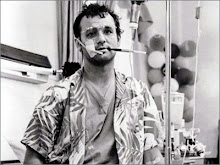Good lord, what a stupid movie.
Stupid, stupid, stupid, stupid. Quentin Tarantino lists this as one of his favorite films, but as QT has demonstrated time and time (and time) again, his favs are usually just fodder ripe for him to successfully overhaul. Where Eagles Dare is Inglourious Basterds with a trans-orbital lobotomy. The dialogue is crassly functional, the plotting needlessly overheated, the acting logy perfunction.
I know I shouldn't be surprised--any film centering on an elite cadre of WWII spies trying to infiltrate a Nazi castle nestled into the Alps isn't sitting with the smart kids at the lunch table--but the stupidity on display here is of rare vintage. This is a movie where as Richard Burton sleepily explains the double and triple crosses to a room of Allied and Axis spies alike, we the audience get the distinct pleasure of watching Burton's strangely nonplussed audience collectively roll their eyes at him.
So, was it worth my time? Absolutely.
Here's the thing about Where Eagles Dare: it is the inverse of The Dirty Dozen. Dirty Dozen has a great first two-thirds. You got a team full of the baddest badasses ever to swap testosterone (if Al Lettieri showed up, the film might be considered a threat to ovulating women), their tough-guy banter as dangerous as the weapons they use in their preparation to storm a Nazi chateau. All the getting-to-know-you chit-chat and mission prep is top-shelf. And then they storm the chateau, and the action grows uninspired, and the characters sprout stereotypes, and I stop caring.
Where Eagles Dare flips that. From the jump till the final hour, I defy you to find one interesting, or even functional, character, or a plot twist that isn't inane, or a suspensely exchange, or anything resembling honest human behavior, or anything resembling exciting dishonest human behavior.
Can't be done.
But then Burton finishes explaining the plot to the numb-nuts in Middle America, and the movie turns into this great, gaudy celebration of violence and destruction. Every ten seconds, you get either something huge blowing up or Clint Eastwood mowing down truckloads of Nazis with his machine gun.
A word about that last bit: I think Clint must kill more people in sixty minutes than he does in all his other films combined. I'm not kidding. There's an extended sequence where he's holed up at the end of a hallway, the whole German army at his heels. His buddies can't help him--they're too busy trying to radio for air support.
So what does Clint do? Mows down every last Nazi motherfucker that enters the hallway, their bodies stacking three, four, five men deep in front of him. By the time he's done, you wonder how Hitler ever managed to amass the strength required to watch his car in a bad neighborhood, let alone wage a two-front campaign.
And the beauty of it all? That's Clint's sole purpose in the film! Richard Burton is saddled with the nominal star duties; all the boring wooing and monologuing and backstory-ing. They even give him an (ostensibly) thrilling hand-to-hand combat fight on top of a moving ski lift to showcase his character's physical prowess, but Burton's so visibly jaundiced by that point that you want less for him to win and more for his assailants to back down, hail him a cab, and check him into Betty Ford for alcohol abuse.
Eastwood does two things the whole movie: growl and shoot things. I think he speaks, and this is a conservative estimate, thirty-fives lines of dialogue over the two-hour and forty minute runtime, but I wouldn't have it any other way.
As they say, a star is born.
Thursday, July 22, 2010
Wednesday, July 21, 2010
You Got To Work That Clint-orus: Introduction
First, let me begin this entry with a lesson in Best Laid Plans.
Warner Bros. recently put out a Blu-ray box set of ten Clint Eastwood films. It is, by no means, a comprehensive hi-def record of his cinematic oeuvre (it's even lacking in his years with the Brothers Warner--a little under a third of his WB pictures are here), but it's a decent overview all the same. I confess there's even something brutally attractive about the kinds of films in the set. One could easily imagine a collection of Clint's Best, yet a number of real stinkers take up real estate. If nothing else, the variance in quality from film to film mirrors the quality shifts throughout Eastwood's fifty-plus years in film, and I like that some of his least inspired cinematic excursions made the cut. What else could explain the inclusion of Where Eagles Dare, Absolute Power, and, the creme de la crap, the Charlie Sheen-co-starring excretion The Rookie?
That said, seeing The Outlaw Josey Wales, Every Which Way But Loose, Bronco Billy, Honkytonk Man, Tightrope, Bird, White Hunter Black Heart, A Perfect World, True Crime, and Invictus would make for an even more satisfying survey set, but like the song goes, "You take the good, you take the bad, and there you have The Facts of Life."
It's an good start for Eastwood on Blu-ray, and I thought it'd make a good column--review all ten, in chronological order.
Here's where that whole "Best Laid Plans" lesson comes into play: the United States Postal Service gerried my copy, losing it to the mysteries of Route 66, and so I sit, dick in hand.
Nothing like a good challenge. The game's still on. The catch: I procure the ten films in the set by hook or by crook. When I review 'em is when I see 'em. I'll try to establish some order, but as I'm culling titles from many different sources, the only constant I can promise is Clint himself.
And really, isn't that enough?
Subscribe to:
Posts (Atom)
